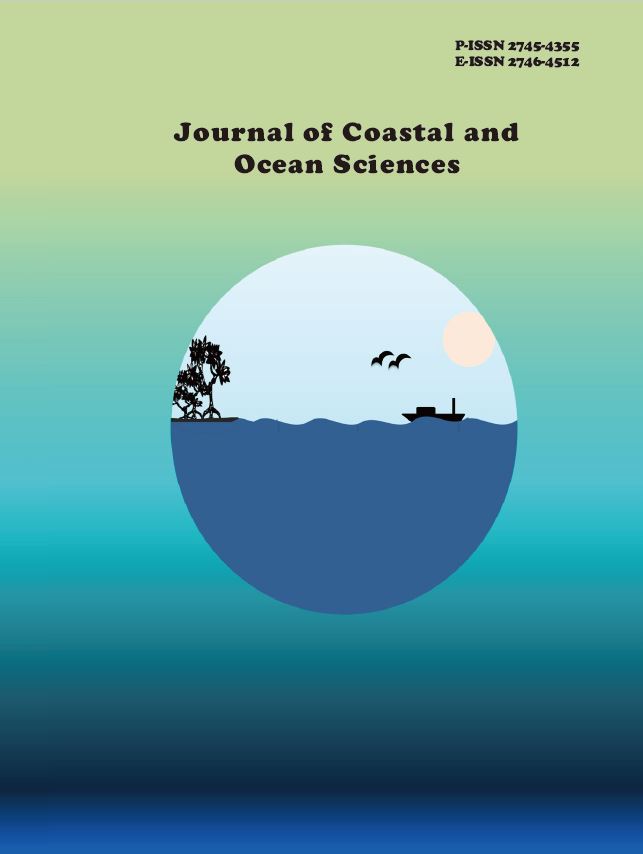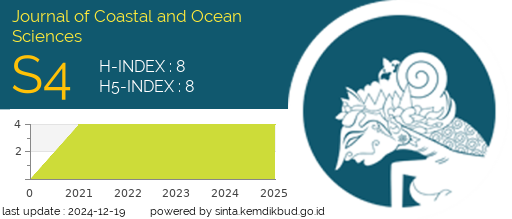Abundance of Chaetodontidae Family Reef Fish and Coral Reef Condition in the Sikuai Island Area, West Sumatra
DOI:
https://doi.org/10.31258/jocos.6.2.108-113Keywords:
Reef Fish, Coral Cover, Sikuai IslandAbstract
Coral reefs are massive piles of sediment from calcium carbonate produced by the phylum cnidaria, class Anthozoa, and order Madreporaria, with the addition of calcareous algae and other organisms that produce calcium carbonate. One group of biota that lives in association with coral reefs and plays a vital role in the coral reef ecosystem is the Chaetodontidae fish. The taking of the Chaetodontidae family as research material is because the coral fish of the Chaetodontidae family are indicator fish for coral reef health that can assess, monitor and predict the condition of coral reefs. Given the importance of the function and the existence of coral reefs. This study aimed to determine the condition of coral reef cover, analyze the abundance of reef fish in the Chaetodotidae family, and determine the relationship between coral reef cover and the abundance of reef fish in the Chaetodotidae family. This study was conducted in December 2024 in Sikuai Island, West Sumatra. This study used survey methods, such as UVC (underwater visual census) and UPT (underwater photo transect). The research location was divided into three stations in the southern part of Sikuai Island because the southern part is relatively protected from large waves during the west wind season. Station I is next to Sirandah Island, Station II is in the harbour area, and Station III is in the abandoned ship area. The analysis showed that the highest percentage of coral cover was found at Station III, namely 45.13%, and the lowest rate was found at Station I, 6.47%. The calculation of reef fish abundance showed that the highest abundance of reef fish was found at station III, namely 5000 ind / ha and the abundance of reef fish at station I was 6.47%.
Downloads
References
Allen, G.R. (1997). Marine Fishes of Tropical Australia and South East Asia. A Field Guide for Angler and Diver.Western Australia Museum.
Amrullah, M.Y., & Rahmadani, W. (2020). Kondisi Ikan Karang Famili Chaetodontidae di Kawasan Zona Inti dan Zona Pemanfaatan Terbatas Taman Pulau Kecil Kota Padang. Jurnal Pengelolaan Sumberdaya Perairan, 4(1).
Efendi, H.M.F., Yuniarti, Y., Syamsudin, M.L., & Ihsaan, Y.N. (2021). Pore Water Nutrient Profile in the First and Second Transitional Season in Teluk Ciletuh, Sukabumi District, West Java. World Sci. News, 153: 43–54.
English, S., Wilkinson, C., & Baker, V. (1994). Survey Manual for Tropical Marine Resources. Australian Institute of Marine Science, Townsville.
English, S., Wilkinson, C., & Baker, V. (1997). Survey Manual for Tropical Marine Resources. Australian Institute of Marine Science, Townsville.
Gea, Y.H. (2018). Hubungan Ekosistem Terumbu Karang dengan Komunitas Ikan Karang di Pulau Unggeh, Kecamatan Badiri, Kabupaten Tapanuli Tengah. Universitas Sumatera Utara. Medan
Gomez, E.D., & Yap, H.T. (1988). Monitoring Reef Conditions. In: Kenchington, R.A., & Brydget ET. Hudson editors. Coral Reef Management Handbook. UNESCO Regional Office for Science and Technology for South East Asia. Jakarta. 187-195.
KLHK. (2004). Keputusan Menteri Negara Lingkungan Hidup no: 51 tahun 2004 tentang Baku Mutu Air Laut. Deputi Menteri Lingkungan Hidup: Bidang Kebijakan dan Kelembagaan LH Jakarta. Retrieved April 17, 2025.
Kohler, K.E., & Gill, S.M. (2006). Coral Point Count with Excel extensions (CPCe): A Visual Basic Program for the Determination of Coral and Substrate Coverage using Random Point Count Methodology. Computers & Geosciences, 32(9): 1259-1269.
Odum, E.P. (1971). Dasar-Dasar Ekologi. Cetakan ke-3. Gajah Mada University Press, Yogyakarta.
Patty, S.I., & Akbar, N. (2018). Kondisi Suhu, Salinitas, pH dan Oksigen Terlarut di Perairan Terumbu Karang Ternate, Tidore dan Sekitarnya. Jurnal Ilmu Kelautan Kepulauan, 1(2): 1-10
Pratama, N. (2021). Kelimpahan Ikan Karang Indikator dan Kondisi Terumbu Karang di Perairan Pulau Poncan, Sibolga. Universitas Riau.
Rahmita, R., Efriyeldi, E., & Thamrin, T. (2022). Hubungan Kondisi Tutupan Karang dengan Kepadatan Megabentos di Pulau Pandan Provinsi Sumatera Barat. Jurnal Zona, 6(1): 28-37.
Rizal, S., Arief, P., & Henky, I. (2016). Tingkat Tutupan Ekosistem Terumbu Karang di Perairan Pulau Terkulai. Jurnal Repository UMRAH.
Rusman, R. (2021). Komposisi Jenis serta Kepadatan Ikan Karang dan Megabenthos pada Ekosistem Terumbu Karang Alami dan Transplantasi Karang di Pulau Bonetambung Makassar. Universitas Hasanuddin.
Setiawan, F., Kusen, J.D., & Kaligis, G.J. (2013). Struktur Komunitas Ikan Karang di Perairan Terumbu Karang Taman Nasional Bunaken, Sulawesi Utara. Jurnal Perikanan dan Kelautan Tropis, 9(1): 13-18.
Suharti, R., Saktiawan, K.Y., Rachmad, B., Triyono, H., & Zulkifli, D. (2018). Kajian Bioekologi Ikan Karang Chaetodontidae sebagai salah Satu Indikator untuk Mendeteksi Kondisi Ekosistem Terumbu Karang di Perairan Taman Nasional Kepulauan Togean, Sulawesi Tengah. Jurnal Kelautan dan Perikanan Terapan (JKPT), 1(1): 12-21.
Tanjung, A. (2014). Rancangan Percobaan (Edisi Revisi 3). Tantaramesra. Bandung. 108 p.
Yuni, Z. (2022). Hubungan Kelimpahan Ikan Karang Famili Chaetodontidae dengan Persentase Tutupan Karang Hidup di Pulau Sikuai. Universitas Andalas
Downloads
Published
Issue
Section
License
Copyright (c) 2025 Bella Yosefa, Thamrin Thamrin, Afrizal Tanjung (Author)

This work is licensed under a Creative Commons Attribution 4.0 International License.





